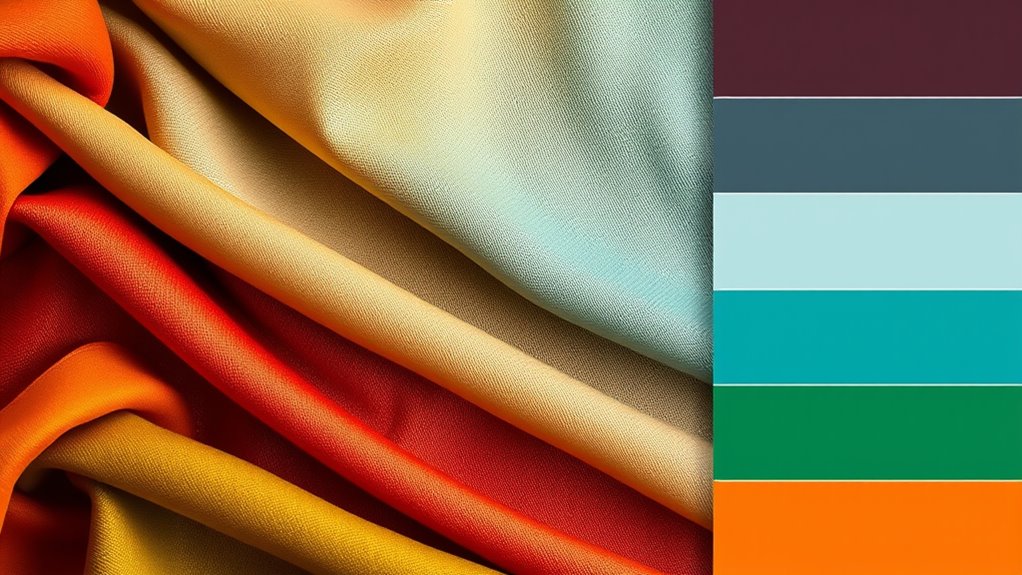Discovering your personal color season helps you select palettes that highlight your natural features, skin tone, and overall style. By identifying if your undertones are warm or cool, you can find colors that boost your confidence and create a harmonious wardrobe. Seasons like Spring, Summer, Autumn, or Winter each offer flattering shades tailored to different coloring. Embracing your season simplifies fashion choices and enhances your glow—exploring more will reveal how to make your palette work best for you.
Key Takeaways
- Determine your skin’s undertone (warm or cool) to identify the most flattering seasonal palette.
- Match your natural coloring to one of the four seasons: Spring, Summer, Autumn, or Winter.
- Select colors from your season’s palette that enhance your eye color, hair, and overall complexion.
- Use seasonal palettes to create a harmonious wardrobe that boosts confidence and natural beauty.
- Understanding your season simplifies shopping and styling, ensuring you wear shades that truly flatter you.

Have you ever wondered why certain colors look better on you than others? The secret often lies in your season analysis and your personal coloring. Understanding these concepts can transform how you choose your wardrobe and help you feel more confident in your appearance. When you learn your season, you’re essentially discovering the palette that complements your natural undertones, hair, and eye color. This isn’t about chasing trends but about finding shades that harmonize with your unique coloring, making you appear vibrant and well-balanced.
Discover your perfect colors by understanding your season and personal coloring for a more confident, harmonious wardrobe.
Your personal coloring is what guides your season analysis. It involves examining your skin’s undertone—whether it leans more towards warm or cool—and then identifying which colors enhance your natural glow. For example, if you have warm undertones, you might fall into the Spring or Autumn categories, which favor warm, earthy, and golden hues. Conversely, if your undertones are cool, you could be a Summer or Winter, suited to softer pastels or bold jewel tones. This analysis isn’t just about picking colors you like; it’s about selecting those that naturally amplify your features and give your skin a healthy, radiant appearance.
Once you know your season, you can curate a color palette that works with your personal coloring. This process simplifies shopping and styling because you’ll have a clear idea of which shades to prioritize and which to avoid. For instance, if you’re a Winter, you’ll look stunning in icy blues, true reds, and stark blacks, while avoiding overly muted or warm shades that can wash you out. If you’re a Summer, soft pastels, cool blues, and dusty roses will enhance your natural look, helping you appear more harmonious and fresh. Knowing your season analysis also highlights the importance of color harmony, which can make your overall appearance more cohesive.
Furthermore, understanding your personal coloring and season analysis gives you confidence. Instead of second-guessing whether a color suits you, you’ll intuitively know what works and what doesn’t. This not only saves time and money but also boosts your self-assurance. When you wear colors that flatter your natural tones, you’ll notice your skin looks brighter, your eyes more vibrant, and your overall presence more polished. It’s a simple yet powerful way to enhance your personal style and feel comfortable in your skin.
In essence, discovering your season and personal coloring is a journey toward discovering what makes you look and feel your best. It’s a practical tool that demystifies color choices and helps you build a wardrobe that truly reflects your unique beauty. When you understand the principles of season analysis, you gain a lifelong resource for making smart, flattering choices in everything you wear.
Frequently Asked Questions
Can I Wear Colors From Multiple Seasons Simultaneously?
Yes, you can definitely mix season palettes and try seasonal color blending. Combining colors from different seasons adds variety and creates a unique style that suits your personality. Just keep in mind that balancing warm and cool tones is key to achieving a harmonious look. Experiment with small accents or accessories to seamlessly blend multiple palettes, making your wardrobe more versatile and personalized without overwhelming your natural coloring.
How Do I Determine My Seasonal Color if I Tan Easily?
If you tan easily, determine your seasonal color by focusing on undertones analysis and seasonal color draping. Even with a tan, look at your skin’s underlying hues—cool, warm, or neutral. Conduct seasonal color draping to see which shades enhance your complexion. This helps you identify your true season, ensuring you wear colors that flatter your natural tones, regardless of tanning.
Are There Any Makeup Shades That Complement Each Season?
Yes, there are makeup shades that complement each season. For warm seasons like Spring and Autumn, opt for earthy tones, warm corals, and golden hues to enhance your natural glow. Cooler seasons like Summer and Winter benefit from soft pastels, cool blues, and jewel tones. Use seasonal makeup tips to select colors that create harmony with your skin tone, ensuring your look is balanced and flattering for your color season.
Can My Season Change Over Time With Age or Hair Color?
Your season can indeed evolve like a chameleon changing its colors. Age-related color shifts and hair color influence may alter your palette, making some shades more flattering over time. As you age or change your hair, your seasonal color profile might shift subtly, so it’s wise to reassess your best colors periodically. Embrace these natural progressions to keep your look fresh and harmonious with your evolving features.
How Do I Adapt Seasonal Palettes for Professional or Casual Wear?
You can easily adapt seasonal palettes for professional or casual wear by mixing seasonal palettes to suit the setting. For a polished look, incorporate more neutral or muted shades from your palette, while casual settings allow brighter or more relaxed colors. Use layering and accessories to adapt colors, making sure they harmonize with your overall look. This approach helps you stay true to your season while fitting different environments seamlessly.
Conclusion
Now that you’ve uncovered the basics of color seasons, you’re gently guided toward discovering palettes that naturally enhance your beauty. Think of it as a delightful journey of self-expression, where every hue whispers a little secret about your unique charm. Embrace the subtle magic of colors that feel just right, making your confidence bloom effortlessly. Remember, it’s all about enjoying the process and celebrating the beautiful harmony within you.










